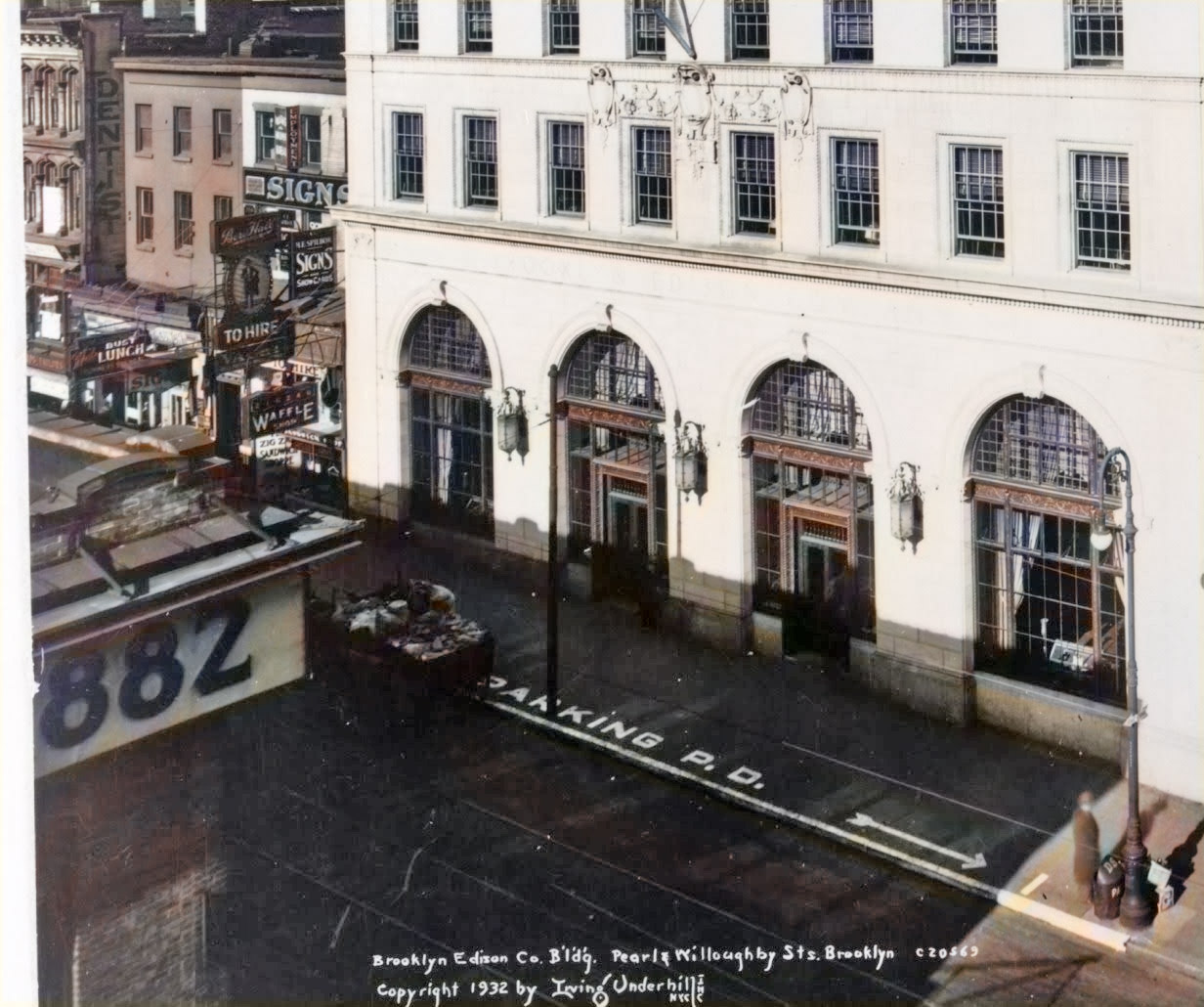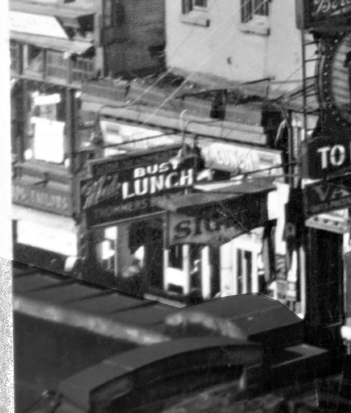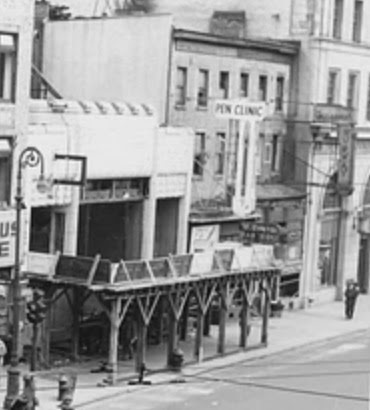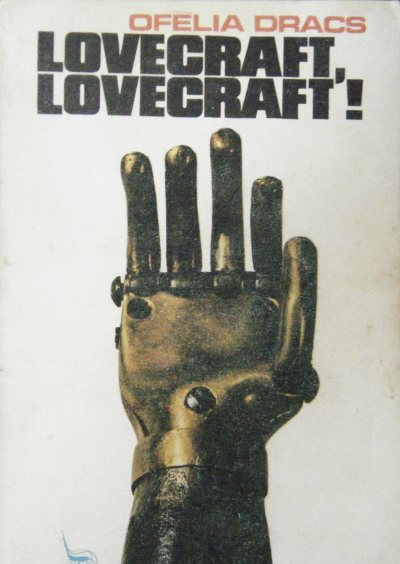Following on from yesterday’s Bickford’s, Brooklyn post, another try at finding the very elusive John’s, one of Lovecraft’s favourite eating and supping places in Brooklyn. Which I’ve searched for before…
the letters vaguely talk of the corner of Fulton and Willoughby Street, and the western end of Willoughby St and even “in Willoughby St”.
First, I found some new data about restaurants low on Willoughby, from court records…
FRITZ’S: “on or about the 24th day of March, 1902, the defendant conducted and now conducts a restaurant at No. 7 Willoughby street, Borough of Brooklyn”. In 1901… “7 Willoughby Street, known as Fritz’s restaurant”.
AUTOMAT: In 1936, “Horn and Harart Company … in the restaurant business … located at 3-5 Willoughby Street in the borough of Brooklyn, New York City” … “the defendant The Horn & Hardart Company owned, operated and controlled a certain restaurant commonly known as the Automat, located at No. 3 Willoughby Street in the Borough of Brooklyn”.
The Brooklyn Historical Society then gave me the location of this Automat, in an early-1940s picture and I usefully spotted that this aligned with an adjacent picture of The Brooklyn Gazette building. This gave me a very useful orientation point…
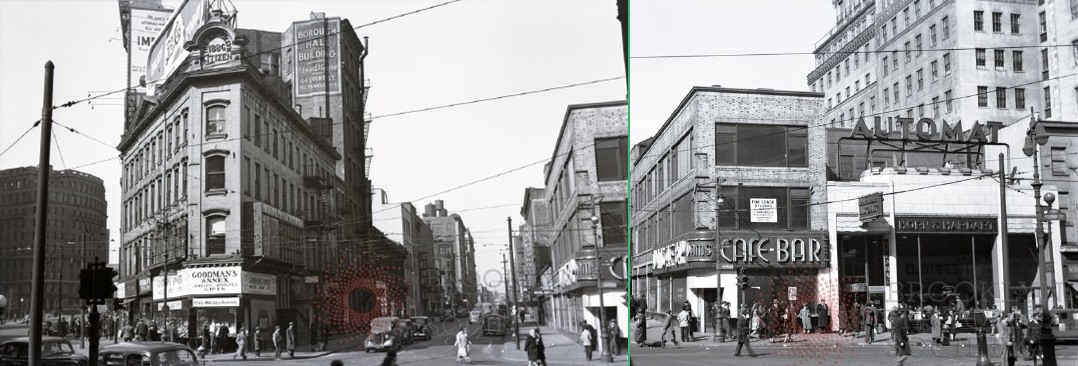
With thanks to the Brooklyn Historical Society. These are not on the 1940s.nyc site and are later on in the 1940s. Prints can be had.
Just to check, in the following picture we look at the same place but from the left-hand side. From the Fulton Street facing side of the Citizen building in 1916, we look across the end of the street and see an anchor sign peeping out from across the road. This can be tallied with a picture of “No. 1 Willoughby”, on which the very same sign is seen. These are New York Board of Transportation pictures, made before the subway construction in 1916. No. 1 would be the “Cafeteria” by the late 1930s, and then the slightly renamed “Cafe-Bar” by the early-mid 1940s.
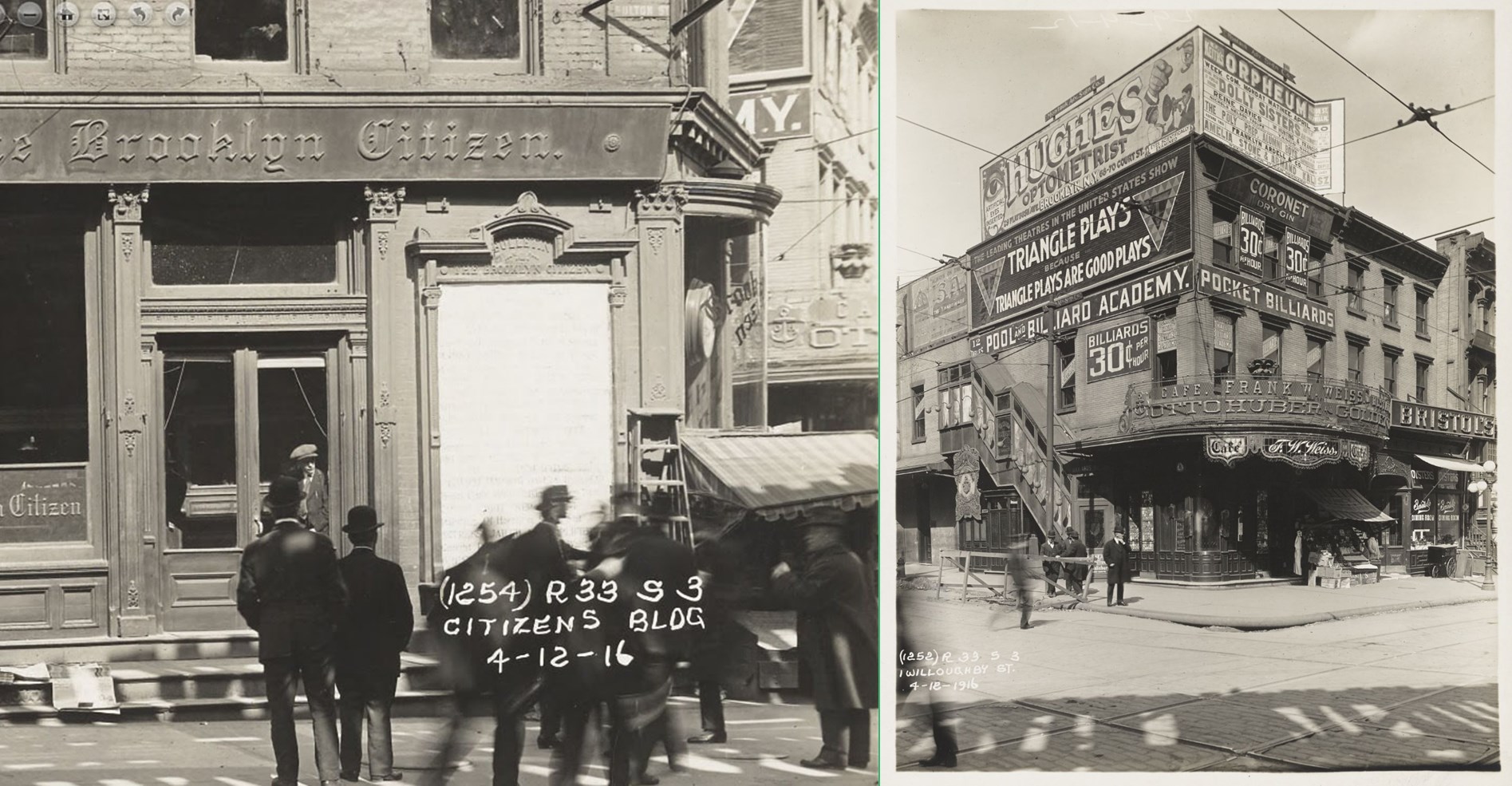
These are also now in the public domain and held by the New York Transit Museum, if you want nice prints made. Again, they are not on 1940s.nyc.
With those two composite views of the same site established, I needed a wider view from the period. Because a great deal has changed by today, and the approximate 1940s.nyc tax-photos map is quite misleading as well — as well as being not very useful on pictures at this particular location. Today Willoughby Street starts with a cursory new plaza containing only No. 15, this being the former Brooklyn Edison Co., built as electricity company offices in 1923/24 (site of the vaudeville/cinema Royal Theater at 11-16 Willoughby, corner of Pearl). Today the rest of the bottom of Willoughby Street, along with the Citizen newspaper building, has been wiped out by the huge multi-lane highway and the plazas either side.
Here’s the more useful orienting bird’s-eye 1910 postcard, and also a 1940s/50s map showing street layouts along with what are probably the subway lines. I think the Elevated railway down Fulton had been dismantled, by then?
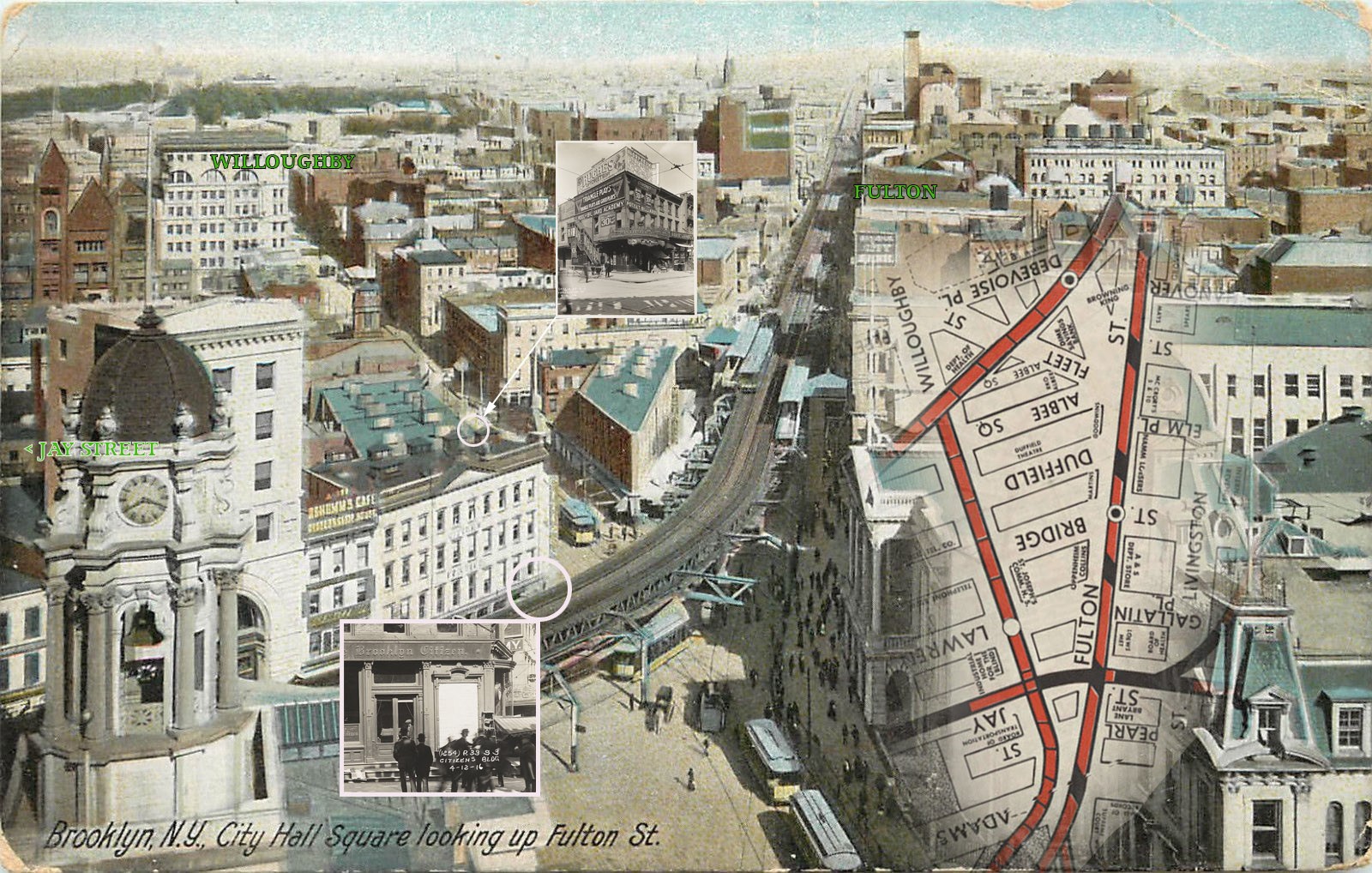
With the location established, I now move along and up the street on the same side, again using the excellent and free 1916 New York Board of Transportation pictures. Here you can see a tiny bit of No. 1 (note the anchor sign), and 3 and 5, in 1916. Note that the number 5 can be seen.
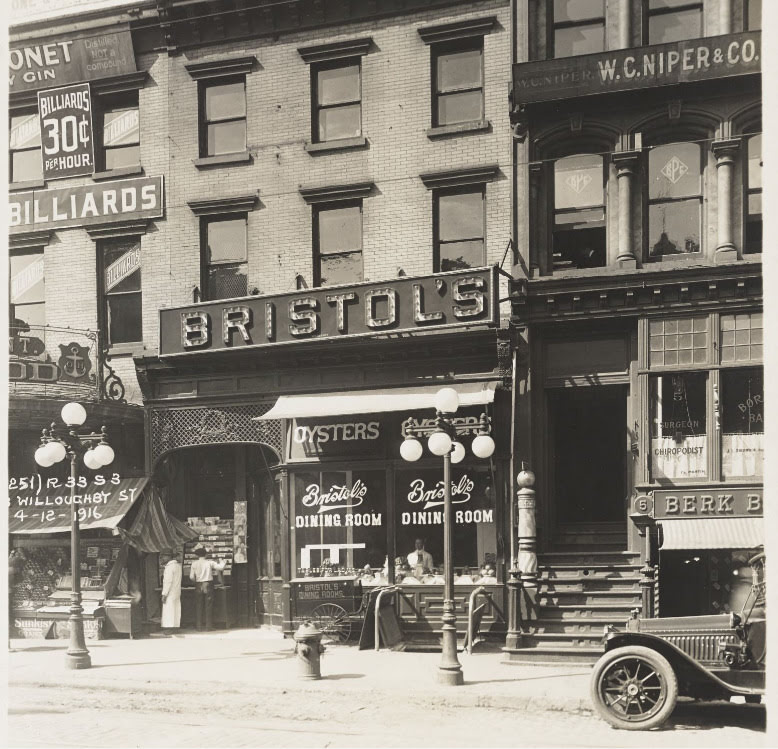
From January 1916 No. 5 was the new Headquarters of the Brooklyn Press Club. Doubtless the proximity to the Citizen newspaper helped there, and also nearby was the best private Directory and Guide-book library in the city. I have also discovered that upper floors of No. 5 later held the office of none other than Lovecraft’s New York friend La Touche Hancock, professional versifier and fellow British Empire loyalist. Here we see him advertising at this address in Student Writer, with such ads running from 1922-24 and also in at least one movie magazine…

By 1931 No. 5 was the “American Book Exchange”. Photographic evidence shows the “Automat” was not there in 1932, but a little later 3-5 was be completely re-made as the wholly new art-deco “Automat”. Thus the “Automat” only appeared after Lovecraft left New York City…
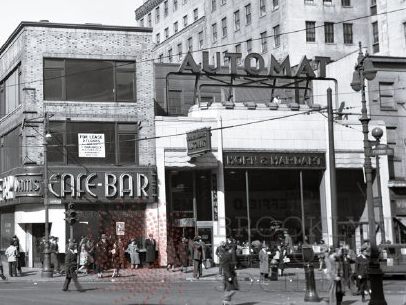
Here in the early 1940s we also see a little glimpse of No. 7, just peeping in at the right-hand edge of this early 1940s picture. It had survived Lovecraft, and appears to be looking much the same as the mid 1920s.
Hmmm. Hang on a minute. “Bristol’s” at No. 3? Sounds familiar. On page 937 of Letters to Family Lovecraft states of July 1931…
All three now set out for dinner — at the old Bristol Dining Room in Willoughby Street near Fulton, next door to the now defunct John’s, which was my Brooklyn headquarters for spaghetti in the old days.
Yup, same place. From Lovecraft’s own words, Bristol’s was “next door to the now defunct John’s”. So… John’s must be either 1, 5, or 7. Yes, I’ve found it was at 7…

Found at last. This ad for John’s is from 1925, at the required “7 Willoughby”. His branch opened in Brooklyn early May 1925, and the owner was the spaghetti-maestro John Pucciati. Who, as it turns out, was also a leading Italian anarchist in New York City, and by that time deep into running one of New York’s key illegal speakeasy joints. More on John tomorrow, and more of the relevant building pictures.
This picture is No. 7 in 1916, nine years before John took it over in May 1925. As we can see in this picture it was a bit pokey, it terms of getting a table with a view…

This lack of views raises a problem. How did Lovecraft sit in John’s and look out at the Brooklyn Citizen building? Which it’s likely he did. Because that was where and how he spotted his cheap suit from Monroe Clothes, across the street from John’s in an upper window. A 1922 copy of The New York Times (thanks Archive.org) brings this Monroe location a little closer than it was in my previous fruitless search for John’s. The NYT has the Monroe Clothes chain’s main Brooklyn branch at 413 Fulton Street, aka the Citizen newspaper building…
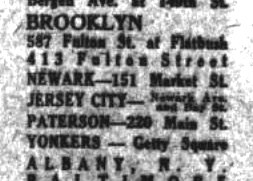
So, it appears that I was led astray by their earlier 1917 “Fulton and Hoyt” address for Munroe, which I looked for some years ago now. It now looks like they moved further up Fulton Street toward Borough Hall at sometime between 1918 and 1922. The company then failed in December 1925 – June 1926 after being “dragged into bankruptcy” by a vexatious creditor. When the official receiver was appointed for the Monroe Clothes bankruptcy in June 15th 1926, it was usefully listed at “409-21 Fulton Street”. This then is further confirmation that they were indeed at 413 Fulton Street by 1922. 413 was likely their main ground-floor entrance, and then they had sales and stock rooms above that stretched across No. 409-21. They were a purely “upstairs” men’s suits store, which is how they offered their famous cheap prices.
But how could Lovecraft have seen the Citizen building when eating at John’s at No. 7? I can only assume that No. 7 had some kind of extended rental across the upper roof-space, in order to have more tables and also more ‘tables with a view’. Which would look something like this…

So, the Citizen building would have been in view, if this was the arrangement. As I’ll explain tomorrow, John had some tight ‘mob’ connections by this time, and thus could have ‘swung’ such an extension across the upper floors, even had the other owners been reluctant. More on John tomorrow, along with fine photos of No. 7.






